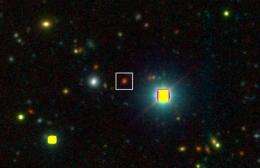The case of the grown-up galaxy

(PhysOrg.com) -- It seems, early on its life, our Universe was a place of extremes.
That’s the conclusion scientists are drawing from new infrared observations of a very distant, unusually bright and massive elliptical galaxy.
This galaxy [in the white square above] was spotted 10 billion light years away, and gives us a glimpse of what the Universe looked like when it was only about one-quarter of its current age.
Measurements show that the galaxy is as large and equally dense as elliptical galaxies that can be found much closer to us. Coupled with recent observations by a different research team - which found a very compact and extremely dense elliptical galaxy in the early Universe - the findings deepen the puzzle over how ‘fully grown’ galaxies can exist alongside seemingly ‘immature’ compact galaxies in the young Universe.
‘What our observations show is that alongside these compact galaxies were other ellipticals that were anything up to 100 times less dense and between two and five times larger - essentially ‘fully grown’ - and much more like the ellipticals we see in the local Universe around us,’ explains Michele Cappellari of Oxford University’s Department of Physics, an author of a report of the research in The Astrophysical Journal Letters.
‘The mystery is how these two different extremes, ‘grown up’ and seemingly ‘immature’ ellipticals, co-existed so early on in the evolution of the Universe.’
Elliptical galaxies, which are regular in shape, can be over ten times as massive as spiral galaxies such as our own Milky Way and contain stars which formed over 10 billion years ago. One way of checking the density of such galaxies is to use the infrared spectrum they emit to measure the spread of the velocities of their stars, which has to balance the pull of gravity.
Measurements of a distant compact elliptical galaxy have shown that its stars were dispersing at a velocity of about 500 km per second, consistent with its size but unknown in local galaxies.
The new study, using the 8.3-m Japanese Subaru telescope in Hawaii, found a ‘fully grown’ elliptical with stars dispersing at a velocity of lower than 300 km per second, much more like similar galaxies close to us.
‘Our next step is to use the Subaru telescope to find the relative proportion of these two extremes, fully grown and compact ellipticals, and see how they fit in with the timeline of the evolution of the young Universe,’ Michele tells us. ‘Hopefully this will give us new insights into solving this cosmic puzzle.’
More information: iopscience.iop.org/2041-8205
Provided by Oxford University


















